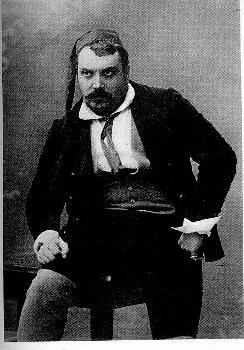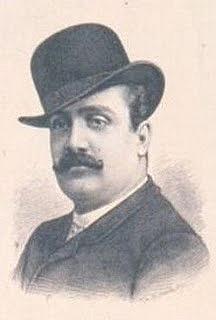Alfonso Garulli
1857 (?) Bologna – 22 May 1915 Bologna
Many sources give Garulli's year of birth as 1866; yet it seems likely that the earlier date 1857, found in some Italian
literature, is correct. Garulli was a bank employee before first joining the Bergonzini operetta company (where
he appeared in Milan in La fille de Madame Angot), and subsequently the Tomba company.
Garulli underwent a laryngeal operation
which was claimed to be responsible for improving his voice sufficiently to undertake an operatic career. He made his
operatic debut in Ravenna in 1881 as Rambaldo (Rambaud) in Robert le diable. Garulli's career advanced to the extent that he
was singing regularly at La Scala (for example in 1887 appearing in Flora mirabilis and Les pêcheurs de perles).
He was a frequent visitor to the major European opera houses (sharing, for example, the role of Canio with De Lucia
in Lisbon in 1900) and travelled further afield to the Americas.
Garulli's repertoire was, like with many tenors of his day,
wide-ranging: it included Carmen, Tannhäuser, La traviata and the "new" verismo works. He worked with the composer Giordano,
with the intention that he should create the role of Andrea Chénier; Garulli fell ill at the eleventh hour, and the role
was taken by Borgatti.
Indeed, ill health seemed to dog Garulli throughout his career. In 1896, for example, Massenet
was adamant that the tenor should appear in the role of Araquil in La Navarraise at La Scala. Again Garulli fell ill;
yet such was Massenet's faith in the singer's art that he suggested that the 'romanza' might be played by the cello
to orchestral accompaniment, so as to spare Garulli for the rest of the work. In the event Garulli was so ill
that De Lucia assumed the role. Massenet and Giordano were not the only composers to admire the tenor.
Mascagni, writing of an enterprise in Vienna in 1892, by the publisher Sonzogno, stated: "...all the greatest Italian
artists were there: Stagno, Bellincioni and Garulli..." Verdi and Puccini also mentioned the tenor and attended his
performances.
Garulli retired from the operatic stage in 1903, emerging onto the concert platform until at least 1907.
In 1887 Garulli had married the soprano Ernestina Bendazzi-Secchi
(1866–1931), and in his short retirement from the stage, opened a school of singing with her in Trieste. He returned
to Bologna at the outbreak of the Great War where he died in 1915. The couple's son Valdo became a music teacher and
composer.
J. P. Myerscough
In RA format
In RA format
| Alfonso Garulli sings | Mireille: O Magali, with Ernestina Bendazzi-Garulli (in Italian)
|
In RA format
In RA format
In RA format
I wish to thank Ashot Arakelyan for the recording (Mefistofele).
Discography
(D = duets with Ernestina Bendazzi-Garulli)
All with piano accompaniment.
Light Blue International Zonophone, Milano, April 1903
X-1540 Aprile (Tosti)
X-1542 Ovunque tu (Van Westerhout)
X-1543 Sera di paradiso (composer unknown) (D)
X-1545 Ideale (Tosti)
X-1547 Lohengrin (Wagner): Mercè, mercè, cigno gentil
X-1548 Mireille (Gounod): Canzone di Magalì (D)
X-1549 Pagliacci (Leoncavallo): Vesti la giubba (without recit.)
Note: Ernestina Bendazzi-Garulli recorded the song Ogni sabato by Gordigiani
on Zono X-1544; it is believed that Alfonso Garulli recorded that song, too,
but the matrix/catalogue number is not known.
Anglo Italian Commerce Company (AICC), Milan 1902
("Hill and Dale" cylinders, later Pathé discs)
80132 Norma (Bellini): Ah! troppo tardi
84002 Ideale (Tosti)
84080 Aprile (Tosti)
84082 Die Meistersinger von Nürnberg (Wagner): Nel verno a piè del focolar
84085 Mireille (Gounod): Canzone di Magalì (D)
84086 Aida (Verdi): Morir sì pura e bella
84088 Mefistofele (Boito): Forma ideal purissima
All items are sung in Italian.
Comments on the records
Garulli's few records are very rare and, it must be said, very sad. The voice is a tired and shaky remnant of what must have been
a fine instrument. One feature of this infirmity is a rather alarming separation of the registers (most apparent
in Tosti's Ideale). We hear a relatively firm lower register, which contrasts with a disembodied, ill-supported
upper register, drained of all colour. The phrasing is, at least in intent, broad, with remnants of a legato style
(for example in the Aida fragment, and the Van Westerhout song). As for Garulli's dramatic credentials, we might
turn to the truncated "Vesti la giubba" where, if again in intent only, Garulli rises to the climax of the piece.
At the end of Tosti's 'Aprile' however, similar vehemence seems somewhat out of place.
The duets with his wife (Ernestina Bendazzi-Garulli) contain some light touches, an ability to differentiate between
piano and mezzoforte, and some sense of rhythm; they are, sadly, more a touching memento of their relationship
than examples of great vocal art. Garulli (and his wife) recorded for the International Zonophone company
and AICC; these were in fact sister companies. The Zonophones had a short life, the company being taken over by
the Gramophone Company in 1903, and most of the records deleted soon after; the AICC cylinders eventually found
their way onto double sided Pathe discs, and are found occasionally in this form.
The gaps in the catalogue/matrix numbers in the discography given above are filled mostly by solo items by Garulli's
spouse.
References: Pietro Mascagni (D. Stivender), Fernando De Lucia (M. Henstock), Record of Singing (M. Scott),
CD inserts (M. Henstock)
I wish to thank Julian Philip Myerscough for the biographical & discographical information and recording (Ovunque tu).
|

